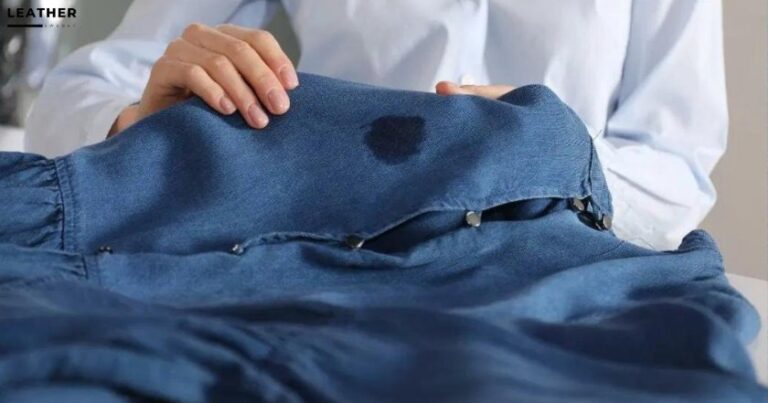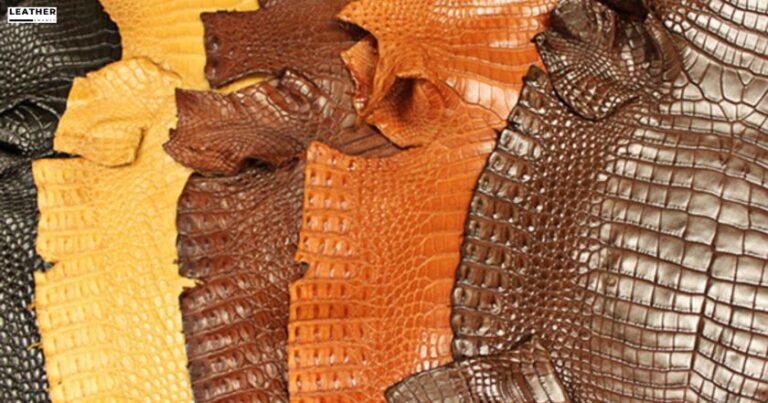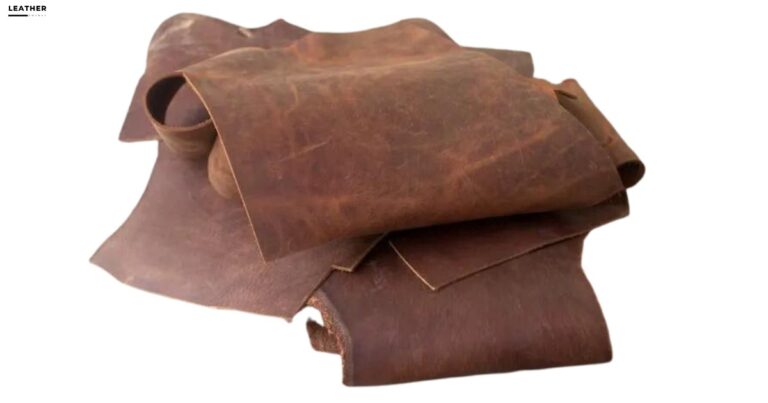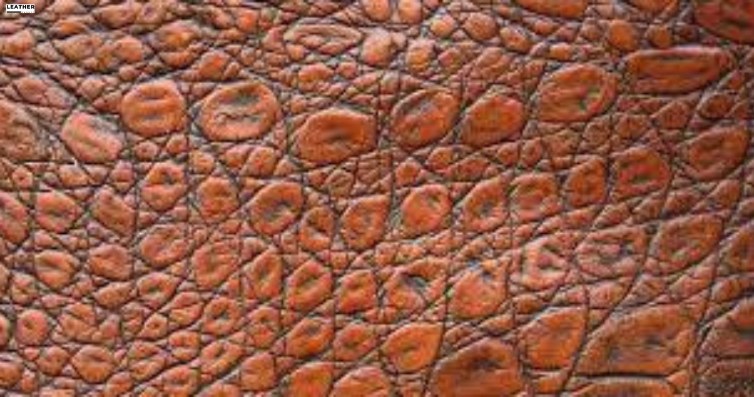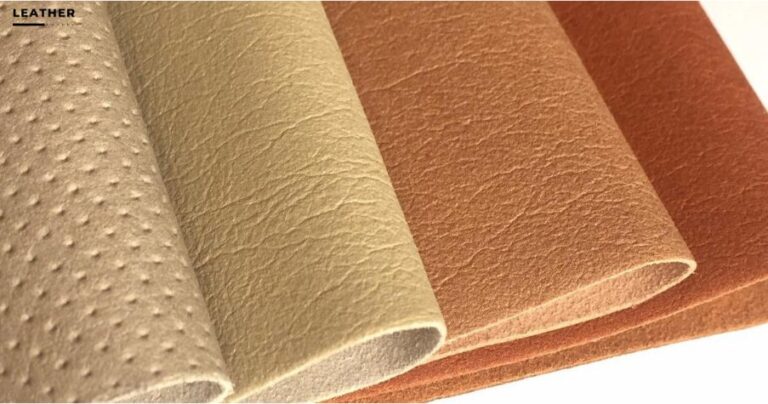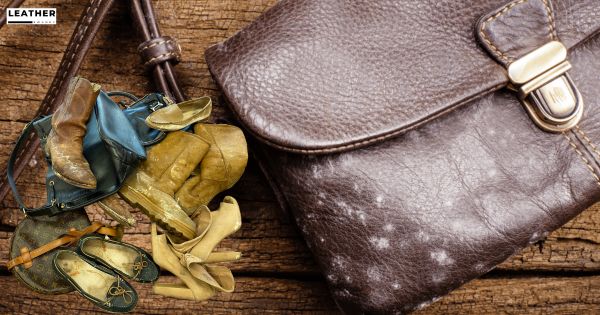How Is Leather Dyed? Explained in 12 Best Ways
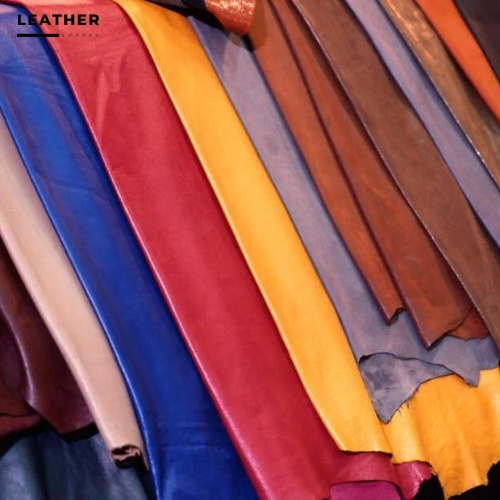
Leather dye is the process of adding color to the leather. Depending on the type of leather, the dyeing process may vary.
Different techniques to dye leather include traditional vegetable tanning, chrome tanning, synthetic dyeing, aniline dyeing, and acid dyes and more. The most common process involves applying the dye with a brush or sprayer.
In this article we’ll explore in detail how is leather dyed, the differences between leather dye and leather color, the various methods of dyeing, the chemicals used, and the impact on the environment.
Plus, we’ll discuss some of the innovations and trends in leather dyeing, and provide some helpful tips and tricks.
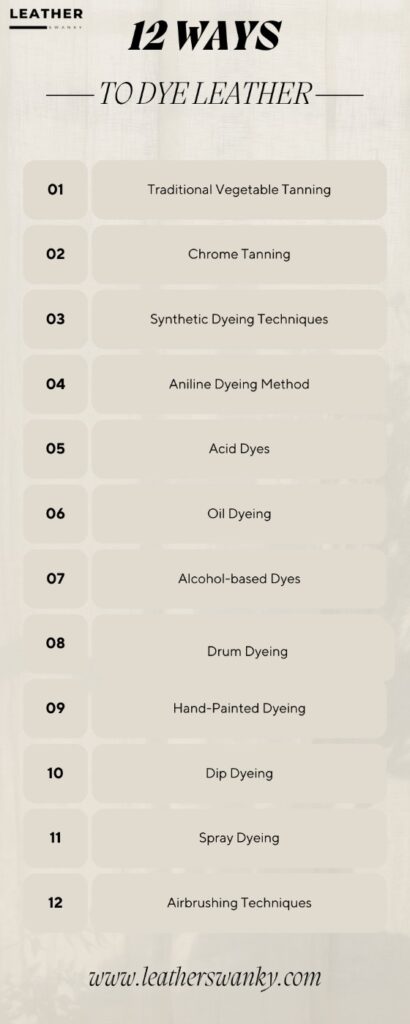
Jump to a Specific Section
- 1 Key Takeaways
- 2 Is Leather Dyed or Painted?
- 3 What is the Difference Between Leather Dye and Leather Color?
- 4 How Is Leather Dyed? 12 Ways
- 4.1 1. Traditional Vegetable Tanning
- 4.2 2. Chrome Tanning
- 4.3 3. Synthetic Dyeing Techniques
- 4.4 4. Aniline Dyeing Method
- 4.5 5. Acid Dyes
- 4.6 6. Oil Dyeing
- 4.7 7. Alcohol-based Dyes
- 4.8 8. Drum Dyeing
- 4.9 9. Hand-Painted Dyeing
- 4.10 10. Dip Dyeing
- 4.11 11. Spray Dyeing
- 4.12 12. Airbrushing Techniques
- 4.13 Suede and Nubuck Dyeing
- 5 Factors Affecting Leather Dyeing Results
- 6 What Chemicals Are Used in Leather Dyeing?
- 7 Environmental Impact of Leather Dyeing
- 8 The Future of Leather Dyeing: Innovations and Trends
- 9 Additional Tips and Tricks
- 10 Final Thoughts
- 11 Frequently Asked Questions
- 11.1 How Long Does It Take to Dye Leather?
- 11.2 What Is the Best Method for Dyeing Leather?
- 11.3 Is There a Difference Between Dyeing and Staining Leather?
- 11.4 What Are the Benefits of Dyeing Leather?
- 11.5 What Color Options Are Available for Dyeing Leather?
- 11.6 What is the difference between dyeing and tanning?
- 11.7 How is the dye applied to leather?
- 11.8 Can antique effects be achieved through leather dyeing?
- 12 Resources Used for Research
Key Takeaways
- Leather dye is applied using a brush or sprayer and is left to dry before being sealed with wax or finish.
- The leather needs to be cleaned and possibly sanded before dye application.
- Some dyes may require mixing with an activator or sealer before applying.
- Leather dye penetrates the leather’s surface and provides a long-lasting, vibrant color, while leather paint sits on the surface and may fade or crack over time.
Is Leather Dyed or Painted?
We often wonder if the leather is dyed or painted. In reality, both processes are used to color leather.
Dyeing and painting are both used to create the desired appearance of leather products.
However, there are some significant differences between the two processes.
- Dyeing Process
- Leather Dye: Leather dye is a type of dye specifically formulated to penetrate and color leather. It is applied to the leather in liquid form and penetrates the leather’s surface as it dries.
- Tanning Process: The tanning process is a chemical process that is necessary to make the leather usable. It is done before the dyeing process and helps to make the leather more durable.
- Painting Process
- Type of Dye: Paint is a type of dye that is not specifically formulated for leather. It is applied to the leather in a thicker form and does not penetrate the leather’s surface.
- Application of Dye: The application of paint is more labor intensive than the application of dye. It requires more attention to ensure that the paint is evenly applied and that there are no streaks or brush marks.
What is the Difference Between Leather Dye and Leather Color?
When it comes to enhancing the look of leather, leather dye, and leather color are two popular options, but they have distinct differences.
- Leather Dye
- Leather Dye is a type of aniline dye used during the leather production process, typically on vegetable-tanned leather.
- This type of dye penetrates deep into the leather, providing a rich, vibrant color that will last for years.
- Leather Color
- Leather Color is a type of paint that is applied to the surface of the leather.
- It provides a glossy, uniform finish, but the color may fade over time.
These two options offer unique advantages and disadvantages, making it important to consider your project’s needs before deciding which is best for you. With this in mind, let’s explore how to dye leather in 12 different ways.
How Is Leather Dyed? 12 Ways
Leather dyeing is a complex process, and there are many different ways it can be done.
We’ll explore 12 of these techniques, including traditional vegetable tanning, chrome tanning, synthetic dyeing, aniline dyeing, acid dyes, and more.
1. Traditional Vegetable Tanning
We use traditional vegetable tanning to dye leather. It is done by submerging the leather in a dye bath made of natural ingredients such as tree bark, leaves, and other organic matter.
The process is time-consuming and labor-intensive, but the end result is a beautiful, durable piece of vegetable-tanned leather.
The process of vegetable tanning begins with the selection of the leather hides, which are then soaked in a dye bath.
The dye bath contains natural ingredients such as tree bark, leaves, and other organic matter. The hides are then left to soak and slowly absorb the dye.
After the hides have been soaked, they are then dried in the sun and then finished with oils, waxes, and other treatments to enhance the leather’s color and texture.
The benefits of vegetable-tanned leather include:
- Natural look and feel
- Durable and long-lasting
- Eco-friendly
- A Rich color that will not fade
- Does not require the use of harsh chemicals
- Retains a natural scent
Traditional vegetable tanning is an effective and safe way to dye leather, resulting in a beautiful, natural, and long-lasting product.
It is an eco-friendly way to create leather goods that will last for many years.
2. Chrome Tanning
Chrome-tanned leather is made by soaking the leather in a chromium salt solution. This process gives the leather a soft and pliable texture, making it ideal for use in many applications.
The leather is then tanned with the chromium salt solution, which binds the leather fibers together.
Once the leather is tanned, the dye can be applied to the surface of the leather for a variety of colors.
The table below outlines the different aspects of the chrome tanning process:
| Process | Description | Benefits |
|---|---|---|
| Soaking | Leather is soaked in chromium salt solution | Gives leather a soft and pliable texture |
| Tanning | Leather is tanned with chromium salt solution | Binds leather fibers together |
| Dye Application | Dye is applied to the surface for a variety of colors | Leather is given a desired color |
3. Synthetic Dyeing Techniques
Synthetic dyeing techniques are also popular methods for coloring leather.
There are two main techniques used in leather dyeing: Surface dyeing and Penetration dyeing.
- Surface dyeing:
- This method is used to provide a color finish on the surface of the leather.
- Leather dye is applied to the surface of the leather, which is then left to dry.
- Penetration dyeing:
- This leather tanning process involves dye penetrating the leather to create a lasting color.
- A binder is used to help the leather dye penetrate the leather and to ensure that the color is properly fixed.
Once the leather dye has been applied, the leather is then left to dry. Techniques such as buffing, burnishing, and polishing can be used to ensure that the color is properly applied and that the leather dye is fixed.
Applying leather dye correctly will ensure that the color is maintained for a long time.
4. Aniline Dyeing Method
Aniline dyeing is a popular method of coloring leather, which involves the use of aniline dyes to create a rich, translucent finish.
This technique requires a specialized type of leather, called aniline leather, to be used as the substrate.
To dye the leather, the dye is mixed with water and applied to the leather with either a brush or a sprayer.
The dye is then allowed to penetrate the leather, and the leather is immersed in the dye bath.
After this process, the leather is then dried, creating a unique and vibrant look. The aniline dyeing method can also be used to create custom colors and patterns on leather.
This technique is popular among leather crafters and artisans, as it allows them to create unique pieces of leather art.
5. Acid Dyes
Uses of acid dyes are varied, including coloring a variety of materials such as wool, silk, nylon, and even plastics.
Acid dyes are used to dye the leather, as the leather can be dyed directly by immersing it in the dye solution. The leather absorbs the dye, which penetrates the leather and adheres to the fibers.
The advantages of using acid dyes are that they are easy to use, require no special equipment, and the color range is extensive. However, some leather may be damaged by the strong acid used to create the dye.
The process of dyeing with acid dyes is relatively straightforward: the leather is immersed in a dye solution and left to soak until the desired color is achieved.
The next step is to rinse the leather to remove any excess dye. Finally, the leather is dried and finished.
6. Oil Dyeing
We use oil dyes to color a variety of materials, including wool, silk, nylon, and plastics. Leather is first dyed by immersing the leather in oil dye. This dye penetrates the leather fibers, allowing for the desired color to be achieved.
Oil dyeing is a process that requires a bit of patience and precision. The leather must be thoroughly soaked in the dye for a certain amount of time and tested periodically to ensure the desired shade is achieved. Temperature and humidity also play a role in the dyeing process.
| Advantages | Disadvantages |
|---|---|
| Penetrates deep | May fade over time |
| Allows for blending of colors | May require multiple dyeing sessions |
| Retains softness of leather | Process requires precision |
| Completely colorfast | May be expensive |
7. Alcohol-based Dyes
We use alcohol-based dyes to achieve vivid and long-lasting colors on various fabrics. Alcohol-based dyes have a low viscosity, which makes them easier to work with than other dyes.
They are applied to the leather in a thin layer, and the dye is absorbed quickly and evenly. Once the dye has been applied, the leather is ready to be sealed with a finish.
This creates a protective layer that helps maintain the vibrancy of the dye and also offers a smooth, glossy finish to the leather.
| Pros | Cons |
|---|---|
| Low viscosity | Not as durable as other dyes |
| Easy to work with | Not as vibrant as other dyes |
| Quick and even absorption | |
| Protective layer | |
| Vibrant and long-lasting colors |
8. Drum Dyeing
This process involves the leather being turned into a drum shape and then placed inside a large rotating drum.
As the drum rotates, the dye is applied to the leather, causing it to be evenly dyed. Drum dyeing is a more precise dyeing technique than other methods, as the drum can produce a more consistent and even color.
It is also a faster method of dyeing leather, allowing for more efficient production. The drum dyeing process is also much more economical than other leather dyeing techniques, as it requires less dye for the same amount of leather.
9. Hand-Painted Dyeing
We, as leather dyers, use hand-painted dyeing as an art form to apply intricate and unique designs to leather pieces. It involves using brushes to:
- Apply the dye: Exert the right amount of pressure and control to apply the dye onto the leather.
- Manipulate the color: Manipulate the amount of dye used to produce the desired color of the leather.
This method gives us great control over the pattern, color, and texture of the leather. It takes a lot of skill and experience to be able to accurately apply the dye with brushes.
Every leather piece painted using this method is unique, as the dyers have full control over the design.
10. Dip Dyeing
As leather dyers, dip dyeing is another technique we use to create unique designs. It involves soaking a piece of leather in dye, and then partially submerging it in water.
This allows us to control the amount of dye that sticks to the leather, creating interesting layered effects.
For example, if the leather is left in the dye for a longer time, the dye will penetrate the leather more and take on deeper colors.
If the piece of leather is only submerged in the dye for a short time, it will create a more shallow, lighter effect.
We can also add water to the dye while the leather is submerged to create even more interesting patterns as the water reacts with the dye.
By manipulating the soaking time and the amount of water on the leather, we can create a variety of unique color combinations.
11. Spray Dyeing
Spray dyeing is another way to create unique designs with leather, allowing us to create intricate patterns and vibrant, eye-catching colors.
To dye leather using this method, it must first be properly made. Different types of leather can be used, such as cowhide, sheepskin, and pigskin.
After the leather is made, a dyeing solution is applied to the leather. This solution is then sprayed onto the leather, creating a uniform color that can be used to create a variety of different patterns and designs.
The dye is then sealed onto the leather and allowed to dry. This method of dyeing leather is a great way to create unique and interesting designs that are sure to stand out.
12. Airbrushing Techniques
Airbrushing techniques allow us to create intricate, vibrant designs on leather without the need for dyeing.
Using an airbrush, we can prepare the leather by applying a primer that helps the color penetrate the leather. Then, the color leather dye is applied to the surface of the leather with a steady hand.
The nozzle of the airbrush allows us to create intricate patterns and designs with the dye, making it an ideal choice for those who want to add a unique touch to their leather items.
Airbrushing techniques are a great way to dye leather as they allow us to add color without the mess that often comes with traditional dyeing methods.
This also makes it easier to achieve an even application of color, as the airbrush nozzle is able to cover specific areas with precision.
Suede and Nubuck Dyeing
Dyeing suede and nubuck fabrics requires special techniques to ensure the dye is absorbed evenly and the colors remain vibrant.
There are two main methods for dyeing these leather types:
- Applying dye directly to the leather surface:
- This method is suitable for smooth leather and is used to produce vibrant colors.
- It is important to use high-quality leather for this process, as it will ensure the dye is properly absorbed.
- Drum dyeing:
- This method is used to dye leathers with a more complex surface.
- It is a more time-consuming process but produces consistent results in terms of color and saturation.
No matter which method is used, it is important for the dyeing process to be done carefully to ensure the best results in terms of color, texture, and longevity.
Factors Affecting Leather Dyeing Results
We consider several factors to ensure optimal leather dyeing results.
- Color: The type of leather and the desired color of the dye must be taken into consideration. Different leathers require different dyes, and the wrong color can create uneven results.
- Penetration: The dye must be able to penetrate the leather if it is to create a uniform color. Different methods of dyeing leather must be utilized to ensure that the dye can penetrate the leather.
- Method: The method of dyeing leather must also be taken into account. Different methods can give the leather different looks and effects. It’s important to choose the right method for the desired result.
- Temperature: The temperature of the dye must also be taken into consideration. Different temperatures can affect the dyeing process and the results. It’s important to ensure that the temperature is just right to achieve the desired result.
What Chemicals Are Used in Leather Dyeing?
We use chemicals such as dyes, solvents, and finishes when dyeing leather to give it color and texture.
Leather dyeing is a process that involves a careful selection of the right chemicals, as they can have a significant effect on the quality of the finished product.
Different types of leather require different types of chemicals for dyeing, so it is important to understand the composition of the leather you are working with.
The type of chemicals used in leather dyeing can also influence the results. For example, some chemicals can cause the leather to become brittle or cause it to fade over time.
Environmental Impact of Leather Dyeing
The environmental impact of leather dyeing can be significant, as the chemicals used can have a negative effect on the environment.
Leather is dyed to achieve a desired color or sheen on the surface, and this process can have a lasting effect on our environment:
- Pollution:
- Water pollution, due to the chemicals used in the dyeing process
- Air pollution, from the release of volatile organic compounds into the atmosphere
- Resource depletion:
- The use of natural resources, such as water, to produce the dye
- The use of energy to power the dyeing machinery
The use of toxic chemicals in leather dyeing can also lead to contamination of soil and groundwater. This can result in health hazards for both humans and animals.
Additionally, the use of leather dyeing can reduce the amount of light that is able to reach the surface, which can have a negative impact on the growth of plants.
The Future of Leather Dyeing: Innovations and Trends
As we continue to strive for sustainability, we’re seeing more and more innovations and trends in leather dyeing that are helping to reduce its environmental impact.
The effects of leather dyeing on the quality of leather and the environment have been a major concern for many years.
However, new dyeing techniques are being developed that can create beautiful, quality leather without sacrificing the environment.
Furniture leather is one of the main industries that is using these new dyeing techniques, allowing them to produce furniture that is both aesthetically pleasing and eco-friendly.
These innovations and trends are encouraging for the future of leather dyeing and could help to reduce its environmental impact significantly.
As a result, more and more people are beginning to take a closer look at how they can make their leather dyeing practices more sustainable.
With continued research and development, we can hopefully continue to reduce the environmental impact of leather dyeing and create beautiful, quality leather products that are both long-lasting and eco-friendly.
The future of leather dyeing looks hopeful, and we can all play a role in making sure that the leather dyeing process is as sustainable as possible.
Additional Tips and Tricks
With more knowledge and resources, we can further reduce the environmental impact of leather dyeing while creating beautiful, quality products.
Here are some additional tips and tricks to consider when dyeing leather:
- To achieve a uniform color across the surface of the leather, you need to use a consistent dyeing process for each piece.
- Apply the dye evenly and smoothly onto the entire surface.
- Use a brush, sponge, or cloth to apply the dye in a circular motion.
- Leather can be dyed using a variety of techniques, including immersion dyeing, spray dyeing, and airbrush dyeing.
- If you want to create a two-tone effect, white leather can be used to dye the leather in different colors.
- Always keep in mind the appearance of leather when dyeing. Different types of leather will take on different shades of color, so experiment with different colors and techniques to find the right look for your product.
Final Thoughts
We have examined the various ways of dyeing leather and explored the differences between dyes and colors.
Leather dyeing has come a long way, with many innovative techniques and materials being developed.
We must also consider the impact leather dyeing has on the environment. With the right knowledge and careful consideration, leather dyeing can be done safely and effectively.
Ultimately, whether you choose to dye or paint your leather, the process is sure to give you beautiful, long-lasting results.
Frequently Asked Questions
How Long Does It Take to Dye Leather?
It typically takes several hours to dye leather. We prepare the leather by cleaning, degreasing, and sanding it before immersing it in dye. This process needs to be monitored to ensure the desired color is achieved.
What Is the Best Method for Dyeing Leather?
We believe the best method for dyeing leather is the airbrush technique. It is precise, allows for easy color adjustments, and dries quickly. Plus, it produces a smooth and even finish.
Is There a Difference Between Dyeing and Staining Leather?
Yes, there is a difference between dyeing and staining leather. Dyeing involves adding color to the leather, while staining is more of a physical process that changes the color of the leather by adding pigments to the surface.
What Are the Benefits of Dyeing Leather?
The benefits of dyeing leather include more vibrant colors, better color fastness, and improved water resistance. It also helps to protect the leather, preventing it from fading or cracking.
What Color Options Are Available for Dyeing Leather?
We have a huge range of color options available when dyeing leather. From deep, bold hues to light, subtle shades, there’s something to suit everyone’s preference.
What is the difference between dyeing and tanning?
Leather dyeing and tanning are two distinct processes in leather production. Tanning is the process of transforming raw hides or skins into leather by treating them with chemicals, whereas dyeing refers to the application of color to already tanned leather.
How is the dye applied to leather?
The dye can be applied to leather using various techniques, including spraying, painting, rubbing, or immersing the leather in a dye solution. The application method depends on the desired result and the type of dye being used.
Can antique effects be achieved through leather dyeing?
Yes, antique effects can be achieved through leather dyeing. By using specific dye techniques, such as dry brushing or layering different colors, a weathered or aged appearance can be created, giving the leather an antique look.
Resources Used for Research
General principles of care, storage and display
Caring for Leather, Skin and Fur
“Leather”:Technical, Practical and Commercial
An Evaluation on the potential degradation of leather dyes by native bacterial species
Leather used in Furniture Upholstery
Conservation of leather and related materials
Leather Processing & Tanning Technology Handbook
Leather Processing, Its Effects on Environment and Alternatives of Chrome Tanning

